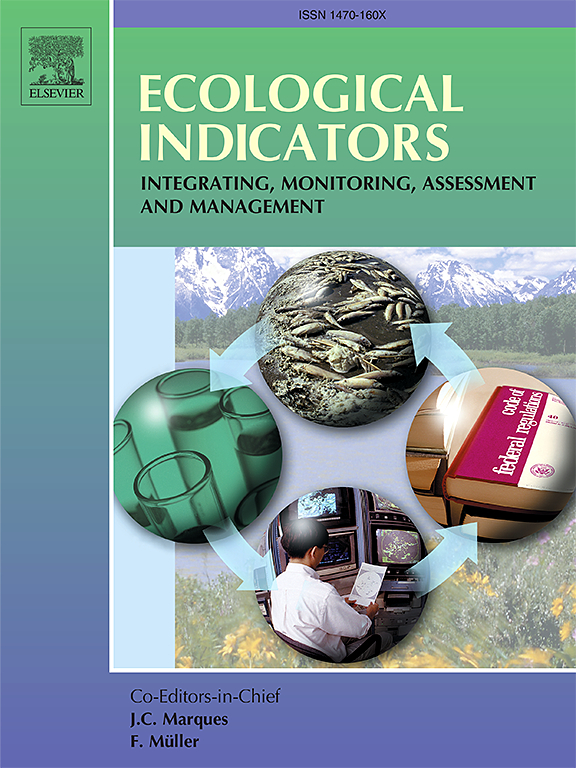Analyzing water footprint and water resources sustainability in China’s arid Northwest with Bayesian network
IF 7
2区 环境科学与生态学
Q1 ENVIRONMENTAL SCIENCES
引用次数: 0
Abstract
Water scarcity in arid regions severely restricts regional economic development. To promote the sustainable development of both the economy and water resources, this study integrates the water footprint (WF) theory with a Bayesian network (BN) model to probabilistically characterize the uncertainties of influencing factors in water sustainability assessment, thus providing a flexible and effective decision-support tool. The BN model, constructed by calculating sectoral WFs and incorporating water sustainability indicators, was rigorously validated and applied to the arid region of Southern Xinjiang (SX). Results indicate that the WF in SX exhibited a fluctuating upward trend from 2004 to 2020, dominated by blue WF primarily driven by the expansion of agricultural irrigation. The model predicts the current probability of water sustainability is 41.9% in SX. Sensitivity analysis reveals that anthropogenic factors significantly influence the WF. Scenario analysis based on four distinct conditions demonstrates that changes in WF and pollutant emissions substantially affect water sustainability. Under future climate scenarios projected to 2030, despite potential increases in precipitation, rising population and economic growth will continue to intensify water demand pressure. Under policy constraint scenarios, regional water sustainability shows improvement. To achieve sustainable development in SX, it is essential to promote efficient irrigation and optimize crop structure, restrict industrial water consumption while enhancing wastewater reuse, improve residential water pricing and conservation measures, develop green infrastructure, and advance virtual water management to balance regional water resources. The BN model effectively elucidates the interactions among factors within the water resource system, providing a robust scientific basis for formulating sound water management strategies.
基于贝叶斯网络的中国西北干旱区水足迹与水资源可持续性分析
干旱区水资源短缺严重制约着区域经济发展。为了促进经济和水资源的可持续发展,本研究将水足迹(water footprint, WF)理论与贝叶斯网络(Bayesian network, BN)模型相结合,对水资源可持续性评价中影响因素的不确定性进行概率表征,从而提供一种灵活有效的决策支持工具。通过计算部门WFs并结合水资源可持续性指标构建BN模型,对该模型进行了严格验证,并应用于南疆干旱区。结果表明:2004 - 2020年,SX地区WF呈波动上升趋势,主要受农业灌溉规模扩大的驱动,以蓝色WF为主;该模型预测,目前SX的水可持续性概率为41.9%。敏感性分析表明,人为因素对WF有显著影响。基于四种不同条件的情景分析表明,WF和污染物排放的变化对水的可持续性有显著影响。在预测到2030年的未来气候情景下,尽管降水可能增加,但不断增长的人口和经济增长将继续加剧用水需求压力。在政策约束情景下,区域水资源可持续性呈现改善趋势。要实现SX的可持续发展,必须促进高效灌溉和优化作物结构,限制工业用水和加强废水回用,完善居民用水价格和节约措施,发展绿色基础设施,推进虚拟水管理,以平衡区域水资源。BN模型有效地阐明了水资源系统内各因素之间的相互作用,为制定完善的水资源管理策略提供了坚实的科学依据。
本文章由计算机程序翻译,如有差异,请以英文原文为准。
求助全文
约1分钟内获得全文
求助全文
来源期刊

Ecological Indicators
环境科学-环境科学
CiteScore
11.80
自引率
8.70%
发文量
1163
审稿时长
78 days
期刊介绍:
The ultimate aim of Ecological Indicators is to integrate the monitoring and assessment of ecological and environmental indicators with management practices. The journal provides a forum for the discussion of the applied scientific development and review of traditional indicator approaches as well as for theoretical, modelling and quantitative applications such as index development. Research into the following areas will be published.
• All aspects of ecological and environmental indicators and indices.
• New indicators, and new approaches and methods for indicator development, testing and use.
• Development and modelling of indices, e.g. application of indicator suites across multiple scales and resources.
• Analysis and research of resource, system- and scale-specific indicators.
• Methods for integration of social and other valuation metrics for the production of scientifically rigorous and politically-relevant assessments using indicator-based monitoring and assessment programs.
• How research indicators can be transformed into direct application for management purposes.
• Broader assessment objectives and methods, e.g. biodiversity, biological integrity, and sustainability, through the use of indicators.
• Resource-specific indicators such as landscape, agroecosystems, forests, wetlands, etc.
 求助内容:
求助内容: 应助结果提醒方式:
应助结果提醒方式:


